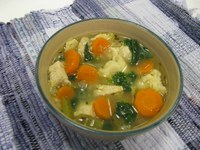Prairie Fare: Exercise Caution When Cleaning, Disinfecting in Time of COVID-19
(Click an image below to view a high-resolution image that can be downloaded)
By Julie Garden-Robinson, Food and Nutrition Specialist NDSU Extension
“Wow!” I exclaimed as I glanced at my husband while I was pushing my grocery cart by the meat and dairy departments of a retail store.
The food areas were well stocked, so that wasn’t the reason for my exclamation.
My nose picked up the pungent scent of a chlorine-based disinfecting solution. My eyes almost started watering, so I quickly pushed our cart to another area.
I was not doubting that this major retailer knew the rules for disinfecting surfaces. Disinfecting uses a higher ratio of bleach to water than sanitizing.
Chlorine bleach solutions have become part of our lives as we battle the invisible viral enemy named COVID-19. This novel form of the coronavirus has become part of our daily conversations.
I have received questions about making homemade alcohol-based hand sanitizers. Commercial hand sanitizers are in short supply at many retail locations.
However, the Food and Drug Administration (FDA) does not recommend making the hand sanitizers you might see circulating on Facebook, Pinterest or other social media sites. Chemical burns from applying “homemade hand sanitizers” to skin have prompted trips to emergency rooms.
Although commercial hand sanitizers are safe, remember that hand sanitizing is not a substitute for hand washing. You know the drill: water, soap, 20 seconds of scrubbing, rinse and dry.
Manufacturers are aware of the hand sanitizer shortage and the supply should catch up, according to the FDA.
Do you know the differences among cleaning, sanitizing and disinfecting?
Cleaning, by definition, is removing dirt, food and some illness-causing germs from surfaces. Cleaning doesn’t kill germs but helps remove them.
You need to clean surfaces before you can reduce the amount of germs, then you can sanitize or disinfect.
In kitchens, we often use the term “sanitizing.” The sanitizing process involves very hot (171 F) water or the application of the correct amount of a chemical solution. Sanitizing agents used in food service include quats, iodine and chlorine. Prepare them according to the manufacturer’s directions and apply to the surface for the specified amount of time.
A typical “sanitizing solution” for use on home kitchen surfaces is 1 tablespoon of bleach per gallon of water.
You probably won’t smell the chlorine in that solution. Be sure to test sanitizers on inconspicuous places to avoid damaging finishes.
In the time of COVID-19, we are asked to take germ killing to the next level and “disinfect” surfaces such as doorknobs, light switches, handles, desks, toilets and sinks.
Do not apply undiluted bleach to a surface. More bleach isn’t better and can be dangerous.
The Centers for Disease Control and Prevention recommends using an unexpired bleach product registered with the Environmental Protection Agency (EPA). Be sure to follow the manufacturer’s directions for application time and the concentration of your solution.
To disinfect surfaces, the CDC provides a general recommendation of 1/3 cup of EPA-registered bleach per gallon of water, or 4 teaspoons per quart.
I write this column with a chlorine bleach bottle from a well-known bleach company in front of me. The recommendation on this bottle for disinfecting is a little different from the CDC: 1/2 cup in 1 gallon of water and a five-minute contact time, followed by rinsing with water and air-drying.
That’s a case in point: Read and follow the manufacturer’s directions for disinfecting. Bleach can vary in its concentration. Cool to warm (75 to 120 F) water, not hot water, is best for chlorine bleach solutions. Do not add other chemicals, and keep the container tightly closed.
Wear disposable gloves and discard them after cleaning and disinfecting the area. Then wash your hands after removing the gloves.
Remember, you are a chemist when you are mixing these solutions. Be accurate. Never mix a bleach solution with a household ammonia solution. Dangerous, potentially deadly gases can be released with certain combinations of chemicals.
In this time like no other in our collective history, we need to take care of ourselves and our community by following the CDC guidance.
On a happier note, remember, you don’t need a cold or the flu to enjoy old-fashioned comfort food such as this delicious soup. Stay well. See https://www.ag.ndsu.edu/food for more information.
Homemade Chicken Dumpling Soup
1 medium chopped onion (about 1 cup)
1 c. chopped fresh celery, including leaves
2 Tbsp. cooking oil of choice
2 c. sliced, fresh, peeled carrots
1/2 tsp. pepper (or to taste)
2 bay leaves
2 c. cooked, diced or chunked chicken
1 tsp. dried thyme
2 c. fresh spinach, large stems removed, chopped
2 quarts reduced-sodium chicken broth
Dumplings
1 egg, beaten
2 c. all-purpose flour
3/4 c. milk
Heat oil in 3-quart or larger kettle or Dutch oven. Add chopped onion and celery and saute on medium-high heat until onion starts to get translucent. Add carrots, pepper, bay leaves, chicken and broth and bring to a very low boil (simmer). Cook for 20 minutes, covered. Add thyme and spinach and continue to cook, covered. Meanwhile, beat egg in bowl; add flour and liquid and mix until just moistened. Let sit to rest while soup starts to simmer. Simmer for 20 minutes. Drop dumplings into broth using one tablespoon to scoop and another to ""drop"" off the spoon. Be careful of hot liquid splashing (slide the dumplings into the liquid). Continue to add dumplings slowly, allowing each to cook. Cover kettle and simmer another 20 minutes. Remove bay leaves. Serve.
Makes eight servings. Each serving has about 260 calories, 7 grams (g) fat, 17 g protein, 31 g carbohydrate, 2 g fiber and 660 milligrams sodium.
(Julie Garden-Robinson, Ph.D., R.D., L.R.D., is a North Dakota State University Extension food and nutrition specialist and professor in the Department of Health, Nutrition and Exercise Sciences. Follow her on Twitter @jgardenrobinson)
NDSU Agriculture Communication - March 26, 2020
| Source: | Julie Garden-Robinson, 701-231-7187, julie.garden-robinson@ndsu.edu |
|---|---|
| Editor: | Ellen Crawford, 701-231-5391, ellen.crawford@ndsu.edu |



